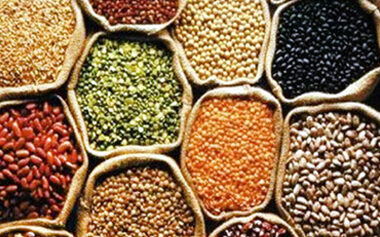Pulses

Pulses are an important commodity group of crops that provide high quality protein complementing cereal proteins for pre-dominantly substantial vegetarian population of the country. Pulses are 20 to 25 per cent protein by weight which is double the protein content of wheat and three times that of rice.The cultivation of pulses builds-up a mechanism to fix atmospheric nitrogen in their root nodules and thus meet their nitrogen requirements to a great extent.
In India, pulses can be produced with a minimum use of resources and hence, it becomes less costly even than animal protein. In comparison to other vegetables, pulses are rich in protein which are less expensive and can be cultivated as an inter-crop and also as mixed crop.
Pulses are mostly cultivated under rainfed conditions and do not require intensive irrigation facility and this is the reason why pulses are grown in areas left after satisfying the demand for cereals/cash crops. Even in such conditions, pulses give better returns. Apart from this, pulses possess several other qualities such as they are rich in protein, improve soil fertility and physical structure, fit inmixed/inter-cropping system, crop rotations and dry farming and provide green pods for vegetable and nutritious fodder for cattle as well.
India is the largest producer, accounting for 26% of world’s production, and consumer with 30% of total pulses consumption in the world.
India has made remarkable progress in enhancing production of pulses during the past 15 years. During 2005-06, the total production of pulses in India was 13.38 million MT, which increased to 25.58 million MT during 2020-21. This shows an impressive growth of 91% or a compound annual growth rate (CAGR) of 4.42%. During 2020-21, chickpea had a lion’s share of 49.3% in the total pulses production.
Among remaining pulses, pigeonpea contributed 16.2%, mungbean 10.3%, urdbean 9.3%, lentil 4.9% and other pulses 9.9%. During the past 15 years, the highest growth in production was observed for mungbean (178%), followed by chickpea (125%), urdbean (90%), pigeonpea (51%) and lentil (34%).
Origin of Pulses
According to history, the origin of Gram is in South West Asia – probably Afghanistan and Persia; Pigeon pea in Africa; Lentil in Turkey to South Iran and Field peas in Mediterranean Region of Southern Europe and Western Asia.
Areas of Cultivation
The main regions with high productivity are Punjab, Haryana, Western Uttar Pradesh, delta region of West Bengal , coastal Andhra Pradesh, Tamil Nadu, Kerala, coastal and eastern Karnataka and some parts of Maharashtra.
Pulses – All India Area and Production
|
|
2018-19 |
2019-20 | 2020-21 | 2021-22 | 2022-23 |
| Area (Million Hectares) |
29.2 | 28.0 | 28.8 | 31.0 | – |
| Production (Million Tonnes) |
22.1 | 23.0 | 25.5 | 27.3 | 26.1 |
Source:Directorate of Economics & Statistics, Department of Agriculture and Farmers Welfare.
2nd Advance Estimates of Production of Food Grains for 2023-24
Note: Pulses includes tur, urad, moong, gram, lentils and other pulses
An All Season Crop
Pulses are grown in all three seasons. The three crop seasons for the commodity are:
- Kharif: Arhar (Tur), Urd (Blackgram), Moong (Greengram), Lobia (Cowpea), Kulthi
- (Horsegram) and Moth
- Rabi: Gram, Lentil, Pea, Lathyrus and Rajmash
- Summer: Greengram, Blackgram and Cowpea
Pulses Exports
Pulses are an important group of crops in India, which is also responsible for yielding large financial gains by amounting for a large part of the exports. The country has exported 4,10,376 MT of pulses to the world for the worth of Rs.2,838 crores during the year 2021-22.
Pulses Export From India
|
|
2019-20 |
2020-21 | 2021-22 |
2022-23 |
2023-24* |
|
Value |
1,533.75 | 2,115.95 | 2,838.70 | 5,395.84 | 4,395.96 |
*2023-2024 (April – January)
Source:Department of Commerce, Ministry of Commerce and Industry, Govt. of India
https://tradestat.commerce.gov.in
References:
- Farmers’ Portal (https://farmer.gov.in)
- Pulses in India: Retrospect and Prospects, Directorate of Pulses Development, Ministry of Agriculture & Farmers Welfare, 2017
- Agricultural and Processed Food Products Export Development Authority (http://apeda.gov.in)
- https://desagri.gov.in/wp-content/uploads/2024/03/Time-Series-Production-2nd-AE-2023-24-English.pdf
